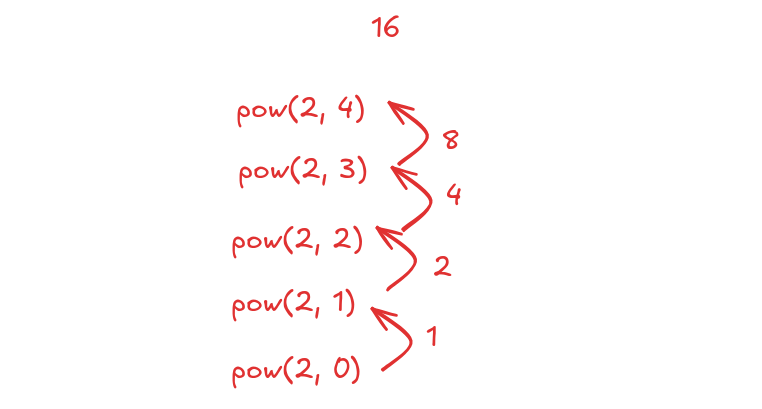Understanding the Basics of Recursion
 Patel Nayan
Patel Nayan
Understanding the Image
The image demonstrates how the power function (specifically, calculating powers of 2) can be implemented recursively. It shows the following steps:
Base Case:
pow(2, 0) = 1(Any number raised to the power of 0 is 1).Recursive Step:
pow(2, n) = pow(2, n-1) * 2forn > 0.
The image walks through the calculation of pow(2, 4):
pow(2, 4) = pow(2, 3) * 2pow(2, 3) = pow(2, 2) * 2pow(2, 2) = pow(2, 1) * 2pow(2, 1) = pow(2, 0) * 2pow(2, 0) = 1
Then, it substitutes the results back up the chain:
pow(2, 1) = 1 * 2 = 2pow(2, 2) = 2 * 2 = 4pow(2, 3) = 4 * 2 = 8pow(2, 4) = 8 * 2 = 16

Recursive Java Code:
Java
public class PowerOfTwo {
public static int pow(int n) {
if (n == 0) {
return 1; // Base case: 2^0 = 1
} else {
return pow(n - 1) * 2; // Recursive step: 2^n = 2^(n-1) * 2
}
}
public static void main(String[] args) {
int exponent = 4;
int result = pow(exponent);
System.out.println("pow(2, " + exponent + ") = " + result);
// Output: pow(2, 4) = 16
}
}
Explanation
pow(int n)Method:Takes an integer
nas input, representing the exponent.Base Case: If
nis 0, it returns 1 (since 2 raised to the power of 0 is 1).Recursive Step: If
nis not 0, it calls itself withn - 1and multiplies the result by 2. This implements thepow(2, n) = pow(2, n-1) * 2logic.
mainMethod:Sets the exponent to 4 (as in the image).
Calls the
powmethod to calculate 2 raised to the power of 4.Prints the result.
How the Recursion Works
When
pow(4)is called, it doesn't immediately know the answer. It callspow(3)and waits for the result.pow(3)callspow(2),pow(2)callspow(1), andpow(1)callspow(0).pow(0)hits the base case and returns 1.The value 1 is passed back to
pow(1), which calculates1 * 2 = 2and returns 2.This 2 is passed back to
pow(2), which calculates2 * 2 = 4and returns 4.The process continues until
pow(4)receives 8 frompow(3), calculates8 * 2 = 16, and returns 16.
Key Points
Base Case: A recursive function must have a base case to stop the recursion. Without it, the function would call itself infinitely.
Recursive Step: The recursive step breaks the problem down into smaller subproblems and calls the function itself to solve those subproblems.
Stack Frames: Each recursive call creates a new stack frame, which stores the function's local variables and parameters. This is how the function "remembers" its state between calls.
Subscribe to my newsletter
Read articles from Patel Nayan directly inside your inbox. Subscribe to the newsletter, and don't miss out.
Written by

Patel Nayan
Patel Nayan
Science student.